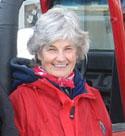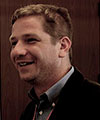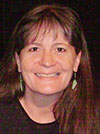To more fully explain the impact that The Empty Space has had on students, faculty, and the public, we have invited people familiar with the Space to tell their own stories.
Kristin Bervig Valentine, Professor Emerita, Arizona State University
In 1976, when I arrived at ASU to join Jan Elsea in teaching Performance Studies (or oral interpretation as it was called then), our only performance space was Stauffer #318. Communication was part of the College of Fine Arts but the theatre faculty didn’t want to give up any of their spaces for our performances. Elsea, Valentine, and the students had performances in this space for several years until the campus police and the fire marshal told us this space was not up to code for public use. Indeed, we had to prop open the ground floor door so audience members could enter for our Friday night, Saturday or Sunday. Jan Elsea then left ASU to start her own successful consulting company in Arizona and D.C.
Next step: “Found Space” was the by-word in performance in the 1970s and early 80s. As audience-stage space, we found spaces in and around the Memorial Union, Danforth Chapel, turned into a mead hall for a performance of Beowulf, the music building’s top floor, and the Theatre Department’s Lyceum theatre. For our, The Milagro Beanfield War show, the theatre department let us use part of a building (now gone) formerly a practice teaching school for the Education College, and renamed by the theatre as “Alternate Space.”
When Janet (McHughes) Palmer was hired in the 1980s to teach Performance Studies, she used her considerable rhetorical skills, to persuade the administration to let us have the kindergarten room at Mitchell School so long as we shared the space with the Dance Department. Because the dance faculty had installed a special flooring for dancers we were told we could only walk on this surface if we were barefoot or wearing soft-soled shoes. We were admonished to NEVER put the boxes, stools, and stands we were then using. The building of the Nelson Fine Arts center relieved us of this stricture.
So now we at least had space. The space was furnished with kindergarten toilets, two walls of cubbies for the children’s personal items, a low ceiling, and a fireplace. Palmer garnered a stable budget for “Interpreters Theatre” so we could buy curtains, two tall poles on which we could hang theatre lights, plus risers and chairs for the audience.
Janet Palmer left ASU to form her own communication consulting company in southern California. After a series of interim faculty in performance studies, we were lucky enough to hire Frederick Corey. His energy and ability to manage the Interpreters Theatre budget meant we could mount shows more professionally, hire a tech person to help with staging and running the lights. We had a light booth fashioned out of used wood at the east end.
The Mitchell School roof leaked when it rained. Once I remember that we had a student hold an umbrella to partially cover the light board and the technician when rainwater threatened. The kindergarten room toilets backed up. We secured a key to the hallway toilets – built for primary school children, not adults. Woe to us when an audience member walked off with the key.
Dustin Goltz, Assistant Professor, DePaul University
The first time I walked (maybe rollerbladed?) into the Empty Space: Early-mid 90s? Sophomore? "The Stories We Never Tell." My first memory was a heated argument, where T.A. and I clashed across lines of race and sexuality. Uncomfortable and out of place, I fled out the door, down the bathroom corridor, turn left, lean back, slowly fall against a dirty brick wall by the rusty water fountain. Jennifer Linde, the director I had just met, crouched down - helped me process this - my anger, my inadequacy, my role in this discussion of culture and difference. I went back inside. T.A. and I continued our sparring, but I stopped looking for resolution. I crafted my monologue, he crafted his, and Jennifer staged these- and many others -into a discussion - where our bodies and stories and energies, for me, rendered the theories from our textbooks boxy, severing, and flat, compared to the embodied and enfleshed theory in space. In that space.
The last time I walked out of Mitchel School (no longer The Empty Space, for "the space" moved), I was alone. I had been packing up boxes for days. Platforms to be moved, stacked neatly against the south wall - the broken and boarded-up window wall Jen and I tried to use as the backdrop for Banging the Bishop - but it became wide and flat and screwed up the energy. The same wall we would mouse along, just behind the curtain in a one-foot space to get from the back door to the stage, and hope all the electrical cords were properly taped down. The curtains that performers would maneuver and rustle behind as lights dimmed - the line between audience and performer a thin, dry, likely flammable piece of curtain. Now, in 2005, curtains pulled, fluorescent lights on, the black box theater appears as the kindergarten classroom that it once was, yet never was to me. The fireplace on the west wall, where I hid in terror before X-Communication, for the very first time, makes sense in this room. The wooden shelves, chained from the ceiling in the NW and SW corners for Deviant, now look ridiculous, though they have been untouched for a decade. And so much stuff! The cabinets by the kiddie sink were filled with decade-old spray adhesive from Tracy's The Good, The Fat, and The Ugly. The north wall cabinets, meant for kindergartners booties and lunches, stacked with years of programs, fabrics, miss-placed lighting gels, a random brick, and a hideous decorative pillow. Piles of cords from technologies, now obsolete. That chair is from Monica's Honeysuckle, carried through half a dozen shows until Undressing Academia with Karma, and Ragan's Soapbox, I think. Hell, that one platform has supported John's music, Sara's voice, Donna's story, John’s gruff drill sergeant, James' scars, Des' boxes, My anger, Jason’s disappointments, and Heidi, and Belle, and Kurt, and Thomas, and Lucas, and Tami, and Melissa, and Leah, and- too much - too many - so much more. One platform.
The first time I heard of the space (Heather Carver sending me to the performance board on the third floor Stauffer for an audition announcement) I remember the quote on the map to Mitchel- “Give me an empty space and I will give you a theatre”- Peter Brook. In my mind, that quote was written in Dr. V's distinct handwriting, but that might be a trick of memory - a conflation of so many scribblings of "approved for 241" in that handwriting, on that board, over the years. As I packed up the last of the boxes and grew overly emotional and nostalgic, I chatted with the ghosts of the space (they are real). I replayed little moments, triggered by standing in different spaces, one last time. I made sure I was taking what I needed, while properly respecting what I had been given.
After years of shows, bodies, and memories, as with all things in life, I think my time with this space was foreshadowed in that first fight with T.A. - my first memory in the space. The words in our dialogue could only do so much – and as for so many who have been in that space – words were not enough. We looked to bodies, and the bodies transformed the space, and hoped, and explored, and resisted, and questioned, and theorized, and challenged theory, and recognized, and misrecognized, and forged communities and alliances, and felt, and hurt, and loved. When I said goodbye to that space, the bodies were already gone, and so Mitchel was no longer the empty space. It was Mitchel. However, the large steel platform set from Credit for Her Country, which had since the 90s been known as "the booth," was impossible to move or break down. I left it, awkwardly and out of place in the middle of this old, dilapidated kindergarten classroom- one final lingering violation of the norms and intentions of the intended architecture and logic of the space.
Leaving Mitchel, I miss the relationship my body had to that space, filthy and rotting with layers of history, jokes, anger, joy, and scholarly inquiry. The Empty Space was/is our laboratory, our playground, our church, our classroom, our research site, our escape, and, well, it was/is ours. That same platform is now in the next empty space. It has held Jen’s embodiment of her father, Kris’s silence, Nicole, and Lydia, and Julie’s discoveries of performance theory, Marjorie’s gender critiques, and countless other interventions. Just give us an empty space, and we’ll keep pushing the ideas forward. The Empty Space is not a location. It’s a mode of engagement, where bodies in space and in relation push communication aesthetics and critical inquiry to different places – places where abstractions, universal claims, and words failed to honor our questions. These questions demand the space for effect, and context, and the situation of bodies in place and in relation. Give us space, and…
Ashley Hill, 2009 Hugh Downs School graduate and recipient of the Kristin Bervig Valentine Undergraduate Scholarship in Performance Studies
The spirit lingers ... I was recently touring the country with Jeep, whom I work for, and a friend of mine was talking about how cool it would be to quit his day job and transform into a college professor. He said, "I can see myself doing it! I would sit down at the desk, read a huge newspaper, wait for class to start, and then open up... 'Brittany, welcome! What are you doing here today?'" His line brought my memory back to the Empty Space when I was a student. I need to thank Dusty Goltz for "awakening and cultivating" my mind as a young freshman. Just like my co-worker, Dusty helped me realize that every day, I could pursue whatever inspired me.
My first day in COM 194 was quite interesting, to say the least. He asked us what exactly we were doing there. No one had asked me that before! Usually in school, we are there because we are told to be there. The freedom to choose to be in a selected class was something new! Dusty had brought in a variety of objects ranging from toilet paper to Swiffer-like household cleaner. In our randomly selected groups, we had to describe what the object was. The exercise was about seeing the world with a new set of eyes. As nervous undergraduate students, a lot of us just saw the object for only what it was.
Throughout my foundation at ASU, the thought of the "toilet paper" always comes back to me. That class challenged me to realize that we create our own reality. During one lecture, I was debating whether or not I should go to Nashville for the evening, whatever he said, struck a chord that said, "Ashley, just go and try it!". Since that class, I have been challenged to look at the world with a new perspective and purpose. Sadly, that class came to an end. After our final, I caught Dusty at the drinking fountain and he explained we had an entire Performance Studies department, "sometimes we even have performances at the 'Empty Space!'".
The first time I went to the Empty Space was to see Marjorie's "My Femininity". Her performance about gender discourses opened a plethora of ideas. I realized that the communication department had an open "space" to perform. I was thrilled to know that there was more to communication than public speaking!
From Kimberlee Perez, Dusty Goltz, Jennifer Linde, and Kristin Valentine, the Empty Space has graced us with a rock star team of Performance Studies educators that have been able to share their stories with us in the space. Throughout their teaching, it became an open box for dreams that can be performed without inhibitions or judgment.
To this day, the "Empty Space" has created a new and ambitious spirit within my life. From voice exercises like "Toy-Boat" and "Red Leather/Yellow Leather", to the ghost interfering with my elaborate multi-screen projections...it became a safe place to experiment and rewrite the endings to my past. However, it wasn't until I graduated that I was aware of the Empty Space "spirit." In this digital age, I was baffled...I said, "There is a big green translucent orb on the photo." With a smile, Linde said, "Yes, there is a ghost in the space...but don't worry, it is a friendly ghost." No wonder we always had "technical issues" all those years! That ghost was playing tricks on us!
The spirit lingers in the space...when you are receptive...it will "awaken and cultivate" your mind, just like it did for me many moons ago. It may even take you back to where you started...chatting with a friend about "what you are doing." To many more moons to rise in the Empty Space...
Jennifer Linde, Artistic Director, The Empty Space
To walk into The Empty Space is to walk into the possibility of performance. My first entry into ASU performance studies and the wonderful possibilities of The Empty Space happened in 1993 when I directed a cast of undergraduate and graduate students in an original performance about letter writing. Rehearsals at Mitchell School were about gathering in a close circle on the hard brown folding chairs on the black wooden stage and witnessing magic. They were about poetry and laughter, personal narratives and dance; a black stool—center stage—just waiting to be filled. And oh did we fill that stool! We worked creatively and collectively to bring performance alive. But, for me, it began in that circle looking into the eyes of students who were brave enough to risk doing something completely different, a bit scary, and eventually so rewarding.
Nearly twenty years later, I still gather with students in a rehearsal circle at The Empty Space. It is now a circle of green padded chairs and the floor is black rubber-not wood. We have wireless internet, computers, a green room, a 12ft grid, and bathrooms that do not require a key. Progress. I remain nostalgic about Mitchell School, yet deeply grateful for the opportunities that our new Space at Cornerstone offers. We have hosted talented performers from across the world, provided the community with a place to talk to one another with civility, nurtured young writers and performers, encouraged activism, laughed and cried, and embraced the possibility of performance. Many things have changed, yet some things remain the same. There is a black stool—center stage—just waiting to be filled. I welcome you to join our circle…



